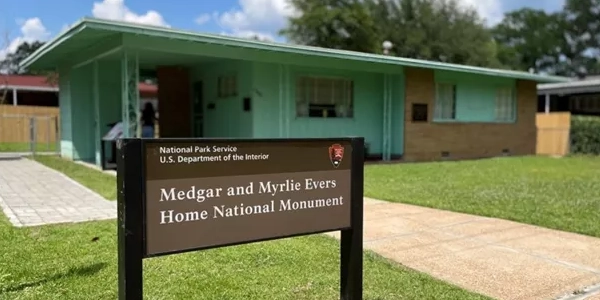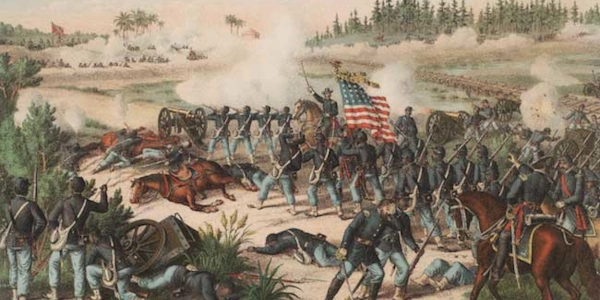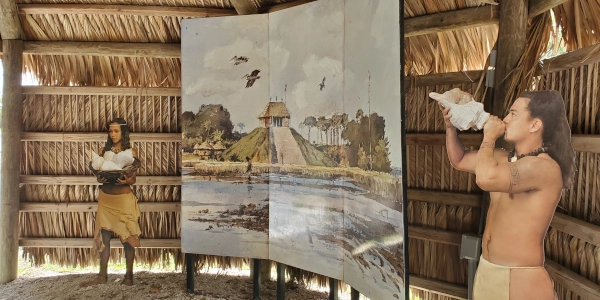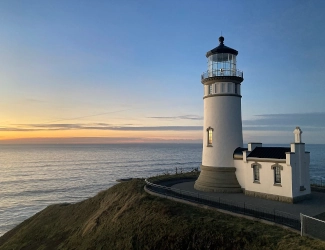
Image above: North End Lighthouse at Cape Disappointment/Fort Canby, one of three forts defending the entrance to the Columbia River, and now a State Park, 2022, Mattsjc. Courtesy Wikipedia Commons C.C. 4.0.
Spotlight on Lesser Known History
Harbor Defenses
of the Columbia River
Oregon/Washington
America's Best History Spotlight
On this page we're going to Spotlight the lesser known historic sites and attractions that dot the history landscape across the USA and are worth a visit if you're in their area. And while they may be lesser known, some are very unique, and will be that rare find. You'll be, at times, on the ground floor, or maybe even know something others don't. It'll be fun. Visit them.

Harbor Defenses of the Columbia River, Oregon
Before we get too far afield in thinking that these forts, now state parks, only tell the story of local forts that saw limited action in battles with the local tribes or to safeguard the passage of the river, there is a lot more to the stories than that. Even though that is important and interesting on their own. But what amazes us about these three forts that protected the Pacific Ocean entrance to the Columbia River and the commerce that would use its waters, is that Fort Stevens, Fort Columbia, and Fort Disappointment (Fort Canby) had their own stories of an international scale. And perhaps the most important, perhaps because its the most recent, is the 1942 attack by a Japanese submarine against Fort Stevens, one year after Pearl Harbor, the first continental USA attack during World War II, as well as previous use during the unique Pig War on the San Juan Islands. We'll cover that and more as we submit the importantance and history of all three forts.
Photo above: Historic homes used by service members during the eras when Fort Columbia was a commissioned military installation. Now part of Fort Columbia State Parks, 2010, Werewombat. Courtesy Wikipedia Commons C.C. 3.0.
Sponsor this page for $100 per year. Your banner or text ad can fill the space above.
Click here to Sponsor the page and how to reserve your ad.
Info, What's There Now, History Nearby
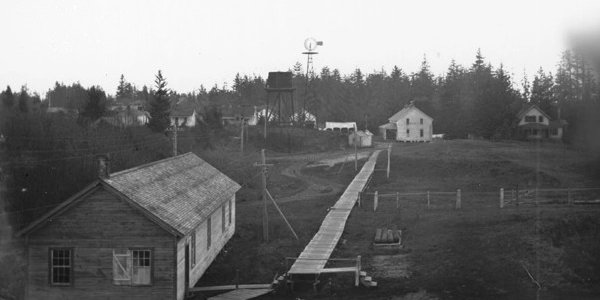
Harbor Defenses of the Columbia River, Oregon
And today you can visit all three fortresses as state parks. Each has history, interpretive centers, including one about Lewis and Clark, as well as the beautiful North End Lighthouse, recently refurbished, history soldier housing, and parts of the remaining forts themselves, each in a different state of repair. Overall, the story here begins with Lewis and Clark, which should not be a surprise. They arrived at Cape Disappointment in 1805, but even that was only after two men tried to cross the river bar, a failure by English Captain John Meares in 1788 and a success by American Captain Robert Gray in 1792. Fast forward to the times of the Civil War, and a Post at Cape Disappointment was built in 1862 to thwart Confederate and foreign raiders; in 1863, Fort Stevens was built to protect the inlet on the south bank. Fort Columbia was built later, from 1896 to 1904, on the Washington side of the river, and served until after World War II.
Image above: Historic photo of Fort Stevens, 1900, H. Ambrose Kiehl Photograph Collection, via Wikipedia Commons. Below: Cape Disappointment, ares that would become Fort Canby, with lighthouse in the background, 2013, Adbar. Courtesy Wikipedia Commons C.C. 3.0.
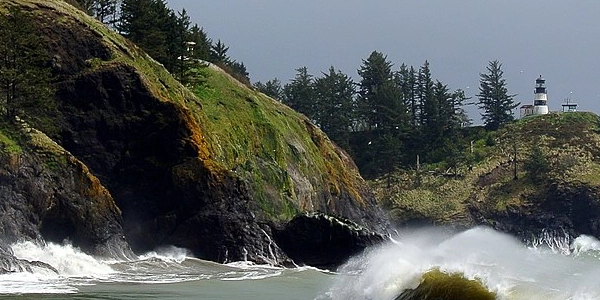
Where Is It
Fort Columbia State Park is lcoated on the Washington side of the river, 475 State Route 101, Chinook, WA 98614. Fort Stevens is located at 1100 NW Ridge Rd, Hammond, OR 97121. The address of Fort Disappointment State Park is 244 Robert Gray Drive, Ilwaco, WA 98624.
What is There Now
Three Forts
Fort Columbia has an interpretive center that is open July 1 to September 5, a Commanding Officers House (closed right now), an interpretive walking tour with waysides, restrooms, picnic tables, two historic houses to rent, campsites, beach walking, boating, and great views. Fort Stevens, beyond its historic footprint, is part of the larger Lewis and Clark National Historic Park, and includes one of the largest public campgrounds in the United States amid over four thousand acres. There are kayak tours, the oldest Civil War era earthworks on the west coast, and an underground World War II era command center, and batteries. The museum and infomation center round out only some of its features. Cape Disappointment State Park. at over two thousand acres, has camping (including cabins and yurts), picnic areas, the Lewis and Clark Interpretive Center, Fort Canby, and the North Head Lighthouse which is open May to September, plus more. Hiking trails take you through forests, around lakes, and onto the beach.
When Open and How Much
Fort Columbia and Cape Disappointment $10 day fee. Day fee at Fort Stevens in $5 per day.
Fees and hours are subject to change.
Websites
Fort Columbia State Park
Fort Stevens State Park
Cape Disappointment State Park
History Nearby
Of course, we think of the trails that brought Lewis and Clark and many others over the Oregon Trail to the Pacific Coast here, as well as other forts, commercial with the Hudson Bay Company, and other natural wonders. Don't miss Fort Vancouver or Lewis and Clark, they are National Park Service Sites, as is Oregon Caves National Monument, a bit further away. But there are so many historic sites here, both natural and man oriented, leave yourself plenty of time to wander.
-
Fort Vancouver
-
Lewis and Clark NHS
-
San Juan Islands
-
Oregon Caves NM
-
Vista House
-
Oregon National
Historic Trail
Photos, History, and More Spotlights
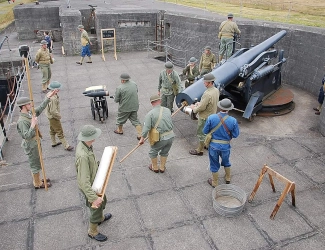
Fort Stevens
Built during the Civil War in the years 1863-4, it was originally known as the Fort at Point Adams. Named changed in 1865 in honor of territorial Governor Isaac Stevens, who died during the Battle of Chantilly. It was predominantly built in response to the Pig War on San Juan Islands in 1859, whose tensions continued with the British through 1870. Tensions flared again during the 1896–1903 Alaska Boundary Dispute with Great Britain.
After World War I, it became a covert listening post, not only with the United States fleet, but in intercepting message from the Japanese. However, despite that, on June 21–22, 1942, the Japanese submarine I-25 fired 17 shells at Fort Stevens, becoming the first attack on the continental United States during World War II. The submarine had been involved in the attack on Pearl Harbor Although during the 1942 event, the shells missed the fort and only destroyed the backstop of the camp baseball field. The I-25 continued to aerial bomb the Oregon Coast during the Lookout Air Raids.
Photo above: Living history, 249th Coast Artillery, at Fort Stevens State Park, 2017, Whiskeyoregon. Courtesy Wikipedia Commons, C.C. 4.0.
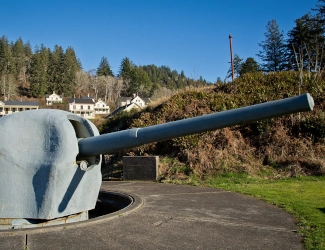
Fort Columbia
Built further upriver than on the coast itself, Fort Columbia was built on the Promotory Chinook Point between 1896 to 1904. It remained in service until 1950 and now includes fourteen historic buildings, an interpretive center, various guns, and many hiking trails on over six hundred acres. During its days of military use, it was used as a Civil Defense Emergency Operating Center, known as Battery 246. The battery was a concrete bunker with controls for the two guns outside.
Image above: Munitions stationed at Fort Columbia, one of three forts that protected the entrance to the Columbia River, and now a state park, 2012, Orange Suede Sofa. Courtesy Wikipedia Commons C.C. 3.0.
Buy Second Edition
America's Best History Timeline

Great book to keep middle school to college students up to date on their American history.
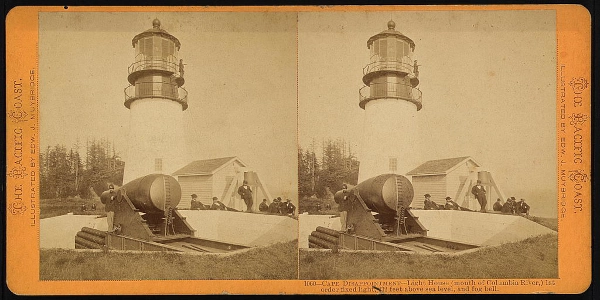
Fort Cape Disappointment/Fort Canby
Fort Canby at Cape Disappointment was built in 1862 as defense against Confederate and British attacks. The name would change several times during its use, now known as Cape Disappointment State Park. Remaining from the Civil War era, are three batteries; Tower, Left, and Center Battery. Fort Canby was expanded in 1875, and by 1906, it was made part of the triangle of defense including the other two forts along or at the headwaters of the Columbia River. It was expanded another time during World War II. There are a number of remnants from the World War II era, although most are in poor condition.
Photo above: Cape Disappointment lighthouse, 1870, Eadweard J. Muybridge. Courtesy Library of Congress. Below: Panoramic photo of Fort Canby, 1913, Frank Woodfield. Courtesy Library of Congress.


T-Shirts and Gifts from the official souvenirs of Americasbesthistory.com.
About
America's Best History where we take a look at the timeline of American History and the historic sites and national parks that hold that history within their lands.
Photos courtesy of the Library of Congress, National Archives, National Park Service, americasbesthistory.com and its licensors.
- Contact Us
- About
- © 2024 Americasbesthistory.com.
Template by w3layouts.
